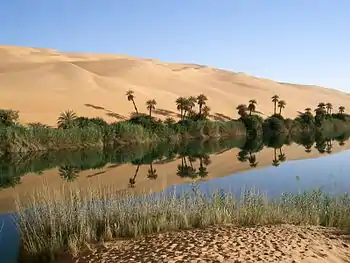Oasis
In geography, an oasis (/oʊˈeɪsɪs/, plural oases, /oʊˈeɪsiːz/) is a fertile area (often having a date palm grove) in a desert or semi-desert environment.[1] Oases also provide habitats for animals and plants.
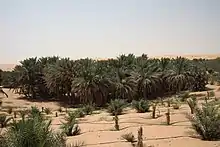
Etymology
The word oasis came into English from Latin: oasis, from Ancient Greek: ὄασις, óasis, which in turn is a direct borrowing from Demotic Egyptian. The word for oasis in the later attested Coptic language (the descendant of Demotic Egyptian) is wahe or ouahe which means a "dwelling place".[2]
Description
Oases are made fertile when sources of freshwater, such as underground rivers or aquifers, irrigate the surface naturally or via man-made wells.[3] The presence of water on the surface or underground is necessary and the local or regional management of this essential resource is strategic, but not sufficient to create such areas: continuous human work and know-how (a technical and social culture) are essential to maintain such ecosystems.[4][5]
Rain showers provide subterranean water to sustain natural oases, such as the Tuat. Substrata of impermeable rock and stone can trap water and retain it in pockets, or on long faulting subsurface ridges or volcanic dikes water can collect and percolate to the surface. Any incidence of water is then used by migrating birds, which also pass seeds with their droppings which will grow at the water's edge forming an oasis. It can also be used to plant crops.
Historical significance
The location of oases has been of critical importance for trade and transportation routes in desert areas; caravans must travel via oases so that supplies of water and food can be replenished. Thus, political or military control of an oasis has in many cases meant control of trade on a particular route. For example, the oases of Awjila, Ghadames and Kufra, situated in modern-day Libya, have at various times been vital to both north–south and east–west trade in the Sahara Desert. The Silk Road across Central Asia also incorporated several oases.
In North American history, oases have been less prominent since the desert regions are smaller, however several areas in the deep southwestern United States have oases regions that served as important links through the hot deserts and vast rural areas. While present day desert cities like Las Vegas, Phoenix, Palm Springs, and Tucson are large modern cities, many of these locations were once small, isolated farming areas at which travelers through the western desert stopped for food and supplies. Even today, there are several roads that go through western deserts like U.S. Route 50 through southern Nevada, and the Mojave Desert that feature small green fields, citrus groves and small isolated supply towns.
Growing plants
People who live in an oasis must manage land and water use carefully; fields must be irrigated to grow plants like apricots, dates, figs, and olives. The most important plant in an oasis is the date palm, which forms the upper layer. These palm trees provide shade for smaller trees like peach trees, which form the middle layer. By growing plants in different layers, the farmers make best use of the soil and water. Many vegetables are also grown and some cereals, such as barley, millet, and wheat, are grown where there is more moisture.[6] In summary, an oasis palm grove is a highly anthropized and irrigated area that supports a traditionally intensive and polyculture-based agriculture.[1] The oasis is integrated into its desert environment through an often close association with nomadic transhumant livestock farming (very often pastoral and sedentary populations are clearly distinguished). However, the oasis is emancipated from the desert by a very particular social and ecosystem structure. Responding to environmental constraints, it is an integrated agriculture that is conducted with the superposition (in its typical form) of two or three strata creating what is called the "oasis effect":[1]
- the first and highest stratum is made up of date palms (Phoenix dactylifera L.) and maintains freshness;
- an intermediate stratum includes fruit trees (orange, banana, pomegranate, apple, etc.);
- the third stratum, in the shade, of herbaceous plants (market gardening, fodder, cereals).
Gallery
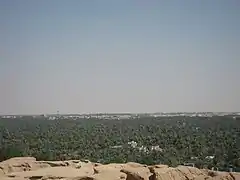 Al-Ahsa Oasis, also known as Al-Hasa Oasis, in Saudi Arabia is the largest oasis in the world
Al-Ahsa Oasis, also known as Al-Hasa Oasis, in Saudi Arabia is the largest oasis in the world
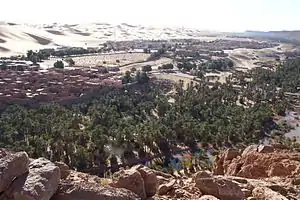
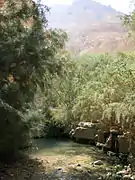
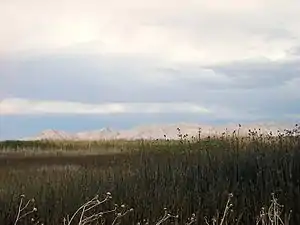
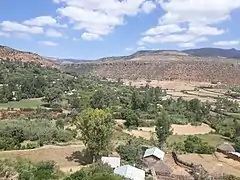 Rubaksa in a dry limestone environment in north Ethiopia is an oasis thanks to the existence of karstic springs
Rubaksa in a dry limestone environment in north Ethiopia is an oasis thanks to the existence of karstic springs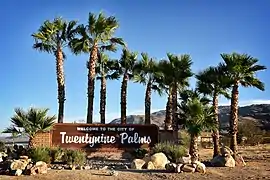 Twentynine Palms sign
Twentynine Palms sign Creosote (Larrea tridentata) on alluvium at Red Rock Canyon National Conservation Area, southern Nevada. United States
Creosote (Larrea tridentata) on alluvium at Red Rock Canyon National Conservation Area, southern Nevada. United States.jpg.webp) Crescent Lake (Yueyaquan) in the Gobi Desert
Crescent Lake (Yueyaquan) in the Gobi Desert
See also
- Great Man-Made River – Network of pipes that supplies water to the Sahara in Libya – the world's largest irrigation project; developed in Libya to connect cities with fossil water.
- Guelta
- Mirage – Naturally occurring optical phenomenon
- Oasification
- Qanat – Water management system using underground channels
- Puquios – Underground aqueducts in Chile and Peru
- Wadi – River valley, especially a dry riverbed that contains water only during times of heavy rain
- Water supply – Provision of water by public utilities, commercial organisations or others
References
- (in French) Battesti, Vincent (2005) Jardins au désert: Évolution des pratiques et savoirs oasiens: Jérid tunisien. Paris: IRD éditions. ISBN 978-2-7177-2584-1.
- Douglas Harper. "Etymonline - Origin of 'Oasis'". Online Etymology Dictionary. Retrieved 2011-07-30.
- "oasis". National Geographic Society. 2011-06-10. Retrieved 2018-04-30.
- Vincent Battesti, The Power of a Disappearance: Water in the Jerid region of Tunisia in B. R. Johnston et al. (eds), Water, Cultural Diversity & Global Environmental Change: Emerging Trends, Sustainable Futures?, 2012, UNESCO/Springer, p. 77-96. ISBN 978-9400717732.
- Vincent Battesti, Resources and Appropriations: Back to the Jerid Oases (Tunisia) after the Revolution, Études rurales 2015, vol. 2013/2 (192): 153-175 ISSN 0014-2182 ISBN 978-2-7132-2398-3
- "Oasis | geological feature". Encyclopedia Britannica. Retrieved 2018-04-30.
Bibliography
- Battesti, Vincent (2005). Jardins au désert, Évolution des pratiques et savoirs oasiens, Jérid tunisien. Paris: IRD Éditions. p. 440. ISBN 9782709915649.
External links
| Wikimedia Commons has media related to: |
 The dictionary definition of oasis at Wiktionary
The dictionary definition of oasis at Wiktionary
